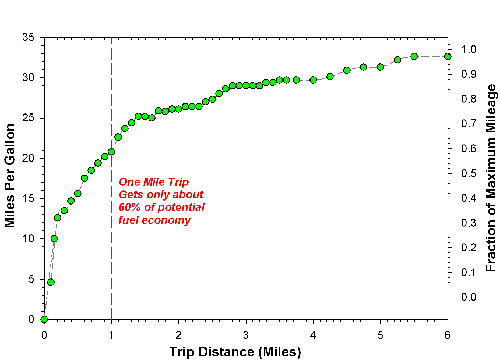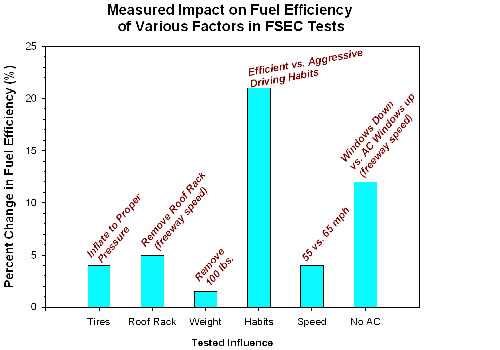
Disclaimer: The views and opinions expressed in this article are solely those of the authors and are not intended to represent the views and opinions of the Florida Solar Energy Center. |
Revised November 2005
Energy Choices for the Road
Nearly 30% of energy used in Florida is consumed by our 13 million personal automobiles. Annual gasoline consumption in Florida is about 7.5 billion gallons. Florida also has more registered cars per capita than any other state in the U.S. - nearly one car for each person. The average Florida automobile is driven over 10,000 miles a year burning about 550 gallons of gasoline and costing its owner about $1,500 in fuel costs alone (not to mention payments, insurance, service, repairs, tires, tags, license etc.). Based on a comprehensive analysis, total automobile operating costs average over $850 per month.
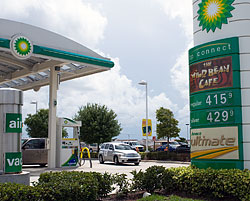 |
Hybrid cars offer an alternative that makes more economic sense as gas prices go up. |
Beyond that is the fact that the more gasoline we use, the more pollution and greenhouse gases we create. For instance, the average car that travels 10,000 miles produces 5.5 tons of carbon dioxide (a greenhouse gas implicated in global warming), 650 pounds of carbon monoxide, 105 pounds of hydrocarbons, 50 pounds of nitrogen oxides and 12 pounds of particulates. Besides saving on fuel costs and reducing pollutants, improving automobile fuel efficiency also reduces our state's dependence on unreliable foreign oil supplies.
Finally, we have the fact that increasing demand for world oil supplies and supply disruptions due to hurricanes has propelled gasoline prices to nearly $3 per gallon. More energy-efficient transportation can mean substantial monetary savings.
Consider Alternatives
- Park your car: walking, riding your bicycle or using mass transit saves energy, especially on short trips.(1) Our test car, which gets 32 miles per gallon (mpg) on the highway, achieved only 17.1 mpg on a 1.8-mile round trip to the grocery store.
- Increase ridership: carpooling always saves.
- Combine several errands and auto trips into one longer trip.
- Use the phone to avoid wasted trips.
- Consider a bus or train. Relax and let someone else do the driving.
- When contemplating a move, consider how the location will affect your commuting distance to work, school, grocery and other weekly errands.
Choose an Efficient Automobile
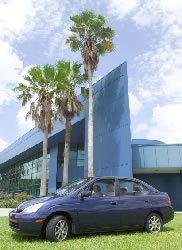 |
Hybrid gasoline-electric vehicles like the Toyota Prius (Rated 60/51 mpg in city/highway driving) may preview the future of automotive transportation Would a “Prius Lifestyle” make an impact on U.S. oil imports? |
For most Floridians, a car is essential. Consequently, the most important single decision you can make is to choose a fuel-efficient automobile. Consider the Environmental Protection Agency (EPA) rated mileage, both for city and highway driving (www.fueleconomy.gov).
Choosing an energy efficient car doesn't mean just buying a small vehicle. For instance, the average fuel economy of a new car sold in the U.S. is now about 22 miles per gallon. However, if you simply bought the most efficient car in the weight class considered, the average fuel economy would immediately rise to 28 mpg.
Note that you also might consider one of the new hybrid electric-gasoline automobiles — particularly if you do a lot of stop-and-go city driving. These include the Toyota Prius (60 mpg city/51 mpg highway), the Honda Civic Hybrid (46/51) and Ford Escape Hybrid SUE (36/31). Not only do these vehicles get substantially better gas mileage, but they also do extremely well with fuel economy in around-town trips.
- Avoid fuel thirsty options. These include:
- large SUVs
- heavier automobiles
- larger engines/higher horsepower
- four-wheel drive
- Use cruise control for improved fuel efficiency if you do
a lot of highway driving.
- Drive the efficient car. In households with two or more automobiles,
choose the more efficient model for longer trips.
- Be aware of fraud! Avoid advertised devices claiming miraculous improvements to fuel economy. The U.S. EPA has investigated more than 100 so called gas-saving device and products. None of these were found to significantly improve mileage.
Mileage May Vary
Relative to the EPA miles per gallon ratings for automobiles, it is
important to note that as the sticker says, "your mileage may
vary." Over recent years, Consumer Reports had come up with what
they consider is more representative testing procedures to determine
automobile mileage than those used by the Environmental Protection
agency. These data can be examined in more detail at:
http://www.consumerreports.org/cro/cars/new-cars/fuel-economy-1005/cu-vs-government-tests/how-they-test-how-we-test.htm
The test results reflect that fact that more driving is now done
under city conditions with heavy traffic and that use of air conditioning
and stop can go driving can influence results. Also, automobile manufacturers
now "game" the tests by hand-modifying the specific models
to be tested-- a practice which CR calls to end. For instance, in tests
on 303 automobiles tested from 2000 - 2005, the average EPA claimed
mileage in city driving was 20.4 mpg whereas CR tested a value of only
14.2! On the other hand, the EPA procedure estimated an average highway
mileage of 26.7 mpg whereas the average tested result was 29.3
mpg. The upshot, however, was that average overall mileage in
modern automobiles will likely average about 10% lower than the EPA
estimates. The disparities were greatest for hybrid vehicles
where the average claimed mileage of EPA (46.8 mpg) were 20% higher
than measured (37.2 mpg). Still, hybrid vehicles were among the thiftiest
of the various models tested-- particularly in city driving. Below
we summarize the results by car type for those with reasonable sample
size:
| Type | EPA Mileage |
CR
Mileage |
| Family Car | 23.7 |
21.3 |
| Upscale Car | 22.9 |
21.2 |
| Luxury Car | 20.7 |
18.0 |
| Sports Car | 21.2 |
21.2 |
| Minivan | 20.8 |
18.0 |
| Large SUV | 14.9 |
13.1 |
| Midsized SUV | 18.4 |
16.5 |
| Small SUV | 20.7 |
18.2 |
| Pickup | 16.7 |
14.5 |
| Small car | 28.6 |
26.4 |
| Small wagon | 25.8 |
22.2 |
| Hybrid car/SUV | 46.8 |
37.2 |
Results for specific automobiles can be seen at: http://www.consumerreports.org/cro/cars/new-cars/fuel-economy-1005/cu-vs-government-tests/vehicle-results-models-a-to-c.htm .
It is also noteworthy that even the Consumer Reports numbers represent average driving conditions. By utilizing the guidance in this publication you can often do better. For instance, the author's automobile, a 2003 Saturn Ion, has an EPA rating of 24 mpg in the city and 32 mpg on the highway and a CR test evaluation of only 17 mpg around town and 35 mpg on the highway, whereas I am able to routinely achieve 31 mpg in local driving and 36 mpg on the highway.
Positive changes are coming however. Based on such findings, the U.S.
EPA is altering the way it computes automobile mileage. These new estimates
will be in place by 2008, resulting in more accurate mileage labels
for automobiles. Generally, mileage estimates will be lower-- particularly
for hybrid type automobiles in city driving. However, the key thing
is that the new labels will more accurately reflect the real fuel economy
you can expect from future automobile purchases.
http://www.nytimes.com/2006/01/11/automobiles/11epa.html?hp&ex=1137042000&en=8b4cdf97cfbecdff&ei=5094&partner=homepage
Maintain Your Car
A car in top running condition will improve fuel efficiency and performance.
- Make sure that your tires are properly inflated. This is
one of the most dependable means to improve fuel economy. Tires
should be inflated to the tire manufacturer's maximum recommended
pressure or the recommended inflating pressure dictated for
a specific car model. FSEC's test car realized a 4% improvement
in fuel economy (1.3 mpg) when the tires were inflated from
27 to 34 pounds psi. Testing done at Edmunds.com on
two automobiles showed very similar improvements to efficiency.
- Keep your car tuned. Fuel economy in our FSEC test car improved
by 6% after a comprehensive 60,000 mile tune-up.
- Reduce wind resistance. Promptly remove unused luggage or boat
racks that will reduce fuel economy. A luggage rack decreased the
mileage of FSEC's test car by about 0.7 mpg (2%) in city driving;
the reduction in efficiency at freeway speeds was nearly 2 mpg (6%).
Closed windows at freeway speeds versus open windows improved mileage
by about one mile per gallon (3%).
- Drop the weight. Golf clubs, bowling balls and other heavy items
belong in the garage, not your trunk. A lighter car gets slightly
better mileage. For every 100 pounds of extra weight in your car,
your mileage will drop by about 1-2%.
- Choose energy conserving oils. The oil you use in your car should
have a label which says "energy conserving." Such oils
reduce engine friction and increase fuel efficiency by about 2-3%
over a single-grade oil.
- Don't use fuel with an octane rating greater than your car requires. Higher octane fuel will not improve fuel efficiency.
Drive Efficiently
"High efficiency driving" can substantially improve your gas mileage.
According to the EPA, driving aggressively will lower your average miles per gallon by 33% on the highway and 5% around town. A recent assessment by Edmunds.com using two vehicles, a boxy Land Rover SUV and a Ford Mustang GT found that "feather foot vs. lead foot driving" improved fuel economy by 35% and 27%, respectively. http://money.cnn.edmunds.com/ownership/driving/articles/106842/article.html
In similar testing done at FSEC on a VW GTI , we saw a 21% improvement in fuel efficiency from efficient driving habits (smooth acceleration, anticipate lights, normal speeds) compared with aggressive driving.2 Also, aggressive driving may not save you much time – and arguably places you in traffic situations more prone to accidents. For instance, a European study showed that aggressive driving reduced travel time only 4%, or the equivalent of just over a minute in a 30-minute trip.
Some specific recommendations:
- Don't warm up the engine. Start it up, and drive away normally.
- When traveling over open highways, use cruise control set at a moderate speed. Most cars get their best mileage at about 45 mph. See figure below:
- Don't speed. Although perhaps the least popular saving-tactic,
observing the speed limit will improve your safety and increase
your gas mileage. FSEC's test car gave 14% better gas mileage
at 55 mph than at 65 mph.
- Minimize braking! Unless you own a hybrid with regenerative braking,
doing everything you can to keep from having to use your brakes when
driving is one of the most powerful means to improve fuel economy,
particularly around town. This means pacing yourself in traffic.
When you see a red light ahead, brake gradually or let the car coast
up to it, trying to time our arrival for the green. Roaring off to
brake for the next light is a disaster for fuel efficiency.
- Avoid sudden acceleration and "jack rabbit" starts — accelerate
smoothly.
- If your car has overdrive gears, use them whenever they will
pull the car smoothly. Overdrive can save fuel around town,
not just on the freeway.
- With a manual transmission, shift to higher gears as soon as practical
without lugging the engine. Sometimes it is possible to skip fourth
gear with a five-speed manual transmission. Many new cars have an
indicator to move quickly and smoothly through the lower gears.
- Avoid rush-hour traffic when possible.
- Combine shorter trips into one long one.
- Park at the first available space rather than driving around to
hunt. You'll get some exercise while saving gas and aggravation.
Remember, over 20% of all accidents happen in parking lots.
- Minimize the time your car idles – you're getting negative miles per gallon. If you're going to be stopped for more than thirty seconds (except in traffic), you'll save fuel and money by turning off the vehicle and then restarting it when you're ready to drive again. Every hour the car idles uses half to a gallon of fuel depending on engine size. Thus, every two minutes that you idle costs you another dime. And don't let the desire for cool lure you into running the engine just to power the air conditioner. Park in a shady spot, shut off the engine and roll down the windows. Never leave your automobile running while you run into a convenience store – it costs you money, is bad for the environment and leaving the car is an open invitation to car thieves. Use common sense when waiting — such as at a railroad crossing — it is often best to shut the engine off and bide your time. And rather than use the drive thru for fast food or banking, simply park and go in.
- If you automobile has a fuel economy meter (instantaneous miles per gallon), by all means use it to help inform you about what measures might help most. If you do not have such a meter, it is possible to purchase one on the aftermarket. One currently available model is the TraxII: http://www.transferflow.com/fms/fuel_monitoring_system.html.
In the graph below we illustrate the influence of various factors influencing automobile mileage in testing done at FSEC. Note the large influence of altering driving style to one that anticipates stops, avoids speeding and rapid acceleration:
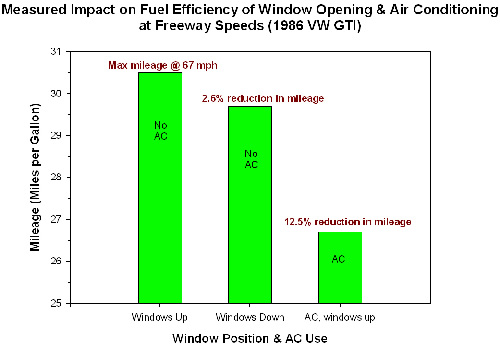
The Future
A number of developments will affect the efficiency of transportation in Florida's future. Hybrid-gasoline-electric vehicles, like the Toyota Prius now offer vehicles which can dramatically improve automobile efficiency — particularly in stop and go driving. Such hybrid vehicles promise to rapidly increase in popularity. Moreover, the technology itself is improving. For instance, current plans by Toyota are that the 2009 Prius will achieve 94 mpg through the use of advanced lithum ion batteries. Also, plug-in hybrids that charge on grid electricity at night may even further extend the potential in future designs. Currently a California company, EnergyCS, is modifying the 2006 Prius as a plug-in hybrid and routinely achieving as-driven efficiencies over 100 mpg.
Many automobile manufacturers have already built very fuel efficient prototype cars. In the U.S., General Motors has produced the TPC, an aluminum bodied two-seater automobile that achieves 74 mpg on the highway, and Ford has produced a diesel-powered prototype that obtained up to 99 mpg in road tests. In Europe, the half-ton Renault VESTA 2 achieved 107 mpg in repeated road testing using a 3-cylinder gasoline engine with light-weight materials and a highly refined aerodynamic design. Beyond hybrids, there are many off-the-shelf technologies that U.S. automobile manufacturers could incorporate to raise fuel efficiency of American cars by up to 30%. They simply need to hear from the public that this is what is what we want. (For instance, see: http://www.msnbc.msn.com/id/9400874/ )
Perhaps one of the most exciting areas of research is the use of hydrogen as an automotive fuel. Hydrogen has an extremely high heat content, burns cleanly and has the potential for very low engine emissions. Hydrogen can also be produced directly from water by electrolysis, using solar electricity from photovoltaic cells. FSEC is conducting research on the production, storage and utilization of this promising fuel. It can be burned efficiently in internal combustion engines or used in fuel cell powered electric vehicles.
While hybrid gasoline electric vehicles (HEVs) occupy the efficiency spotlight today, they likely represent a transition point to the long-term solution — fuel cell automobiles. Hybrid fuel cell vehicles potentially can wean our economy off potentially limited supplies of petroleum fuel. Burning gasoline in millions of automobiles produces massive emissions of greenhouse gases (carbon dioxide) and other effluents associated with global warming, smog and air pollution. Also, since the United States must import 60 percent of our petroleum products, continued dependence on foreign oil still leaves us reliant on countries in the Middle East and elsewhere with volatile or hostile political conditions.
Within a potential hydrogen economy, fuel cell electric vehicles (FCEVs) would utilize compressed hydrogen gas at distributed filling stations. Although the costs of the infrastructure will be very expensive, the potential benefits are equally large. Hydrogen can be produced from water by electricity from wind, solar, nuclear or coal-fired electric generation as well as from natural gas or methane. One analysis which appeared in "Science" shows that hydrogen produced by electricity from wind energy would be comparable in price to current gasoline prices — although reducing the costs of the fuel cells themselves remains a challenging task. Fuel cell powered automobiles are under rapid development. For instance, a project in California will soon see 35 Toyota Prius models converted to run on hydrogen with fuel cells. Honda also has introduced the first fuel cell-powered automobile in North America — the FCX. Ford, DaimlerChrysler, GM and BMW are also soon to be deploying fuel cell-powered automobiles in the U.S. in the near future.
The trip to work is changing too. Telecommuting can reduce energy use and air pollution. And as Florida becomes more urbanized, we can expect to see more transit options. Buses, trolleys, monorails and high-speed trains may serve Florida's largest cities.
With adequate planning, Florida's future transportation needs can be met with less waste of our resources. Use the tips presented here to save energy now, be open-minded to new vehicles, innovative work habits, and new transit transportation energy efficiency can keep us moving to a better future.
Selected References:
"A Guide to Saving Gasoline," Consumer's Research, November, 1990.
Bob Rackleff, "The Economic Drag of Florida's Over Reliance on Personal Vehicle Transportation," National Association of Counties Legislative Conference, March 3, 2000.
D. Parker, "Some Measured Influences on Automobile Gasoline Mileage," Florida
Solar Energy Center, FSEC Research Report RR-25, Cocoa, FL, December,
1991.
U.S. Department of Energy; 2005 Fuel Economy Guide, www.fueleconomy.gov, Washington, D.C.
U.S. Department of Energy, 1982-2005 Gas Mileage Guides, DOE/CE-0019/10, Washington, D.C.
Alexandra Baker, "Fuel Cell Market Survey: Automotive Hydrogen
Infrastructure," Fuel Cell Today, May 25, 2005.
M. Z. Jacobson, W. G. Colella, D. M. Golden, "Cleaning the Air
and Improving Health with Hydrogen Fuel Cell Vehicles," Science, June
24, 2005
http://www.stanford.edu/group/efmh/jacobson/SciencePubHyd.pdf
1. At FSEC in the 1990s, we tested many of the tips associated with improving automobile efficiency to verify the savings' potential. We used a 1986 Volkswagen GTI, which has an on-board computer, to track instantaneous and trip mileage. This automobile has a nominal EPA mileage rating of 28 miles per gallon in the city and 32 on the highway.
2. Tests conducted at FSEC showed mileage improvements of approximately 14% by using the following habits versus "average driving habits." The improvement was nearly 21% when compared to "bad driving habits"

